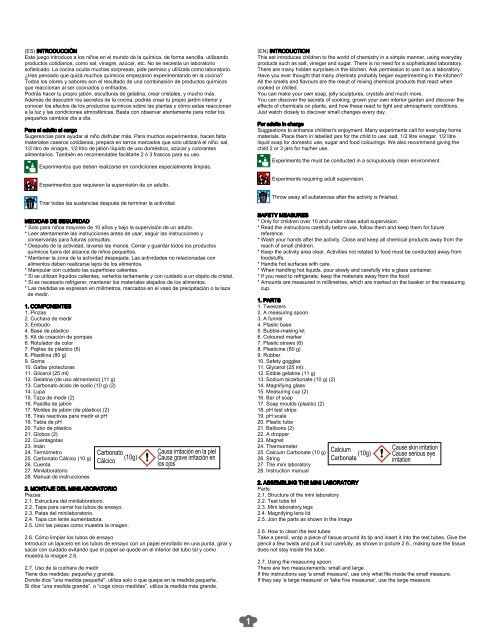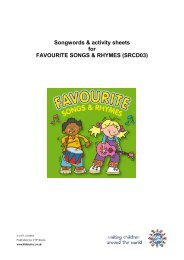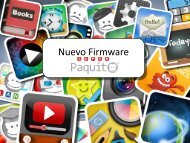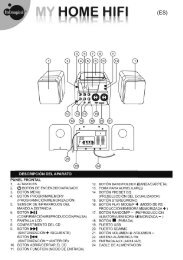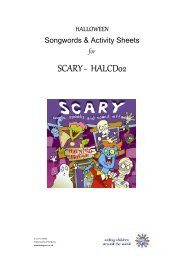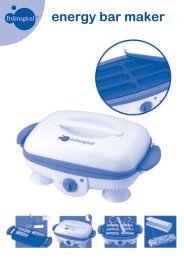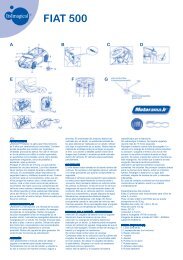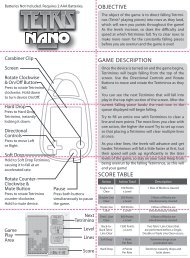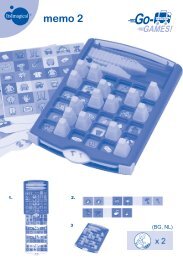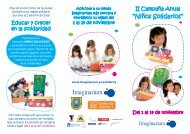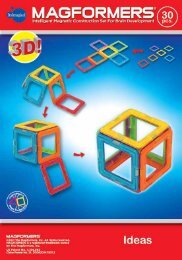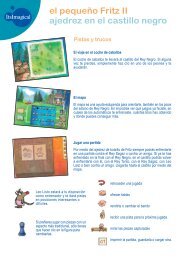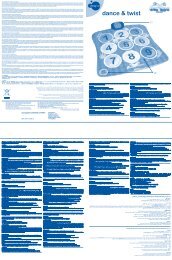66953_Prof CHEM INS_Cover(6L) - Imaginarium
66953_Prof CHEM INS_Cover(6L) - Imaginarium
66953_Prof CHEM INS_Cover(6L) - Imaginarium
Create successful ePaper yourself
Turn your PDF publications into a flip-book with our unique Google optimized e-Paper software.
(ES) INTRODUCCIÓN<br />
Este juego introduce a los niños en el mundo de la química, de forma sencilla, utilizando<br />
productos cotidianos, como sal, vinagre, azúcar, etc. No se necesita un laboratorio<br />
sofisticado. La cocina oculta muchas sorpresas, pide permiso y utilízala como laboratorio.<br />
¿Has pensado que quizá muchos químicos empezaron experimentando en la cocina?<br />
Todos los olores y sabores son el resultado de una combinación de productos químicos<br />
que reaccionan al ser cocinados o enfriados.<br />
Podrás hacer tu propio jabón, esculturas de gelatina, crear cristales, y mucho más.<br />
Además de descubrir los secretos de la cocina, podrás crear tu propio jardín interior y<br />
conocer los efectos de los productos químicos sobre las plantas y cómo estas reaccionan<br />
a la luz y las condiciones atmosféricas. Basta con observar atentamente para notar los<br />
pequeños cambios día a día.<br />
Para el adulto al cargo<br />
Sugerencias para ayudar al niño disfrutar más. Para muchos experimentos, hacen falta<br />
materiales caseros cotidianos, prepara en tarros marcados que solo utilizará el niño: sal,<br />
1/2 litro de vinagre, 1/2 litro de jabón líquido de uso doméstico, azúcar y colorantes<br />
alimentarios. También es recomendable facilitarle 2 ó 3 frascos para su uso.<br />
Experimentos que deben realizarse en condiciones especialmente limpias.<br />
Experimentos que requieren la supervisión de un adulto.<br />
Tirar todas las sustancias después de terminar la actividad.<br />
MEDIDAS DE SEGURIDAD<br />
* Solo para niños mayores de 10 años y bajo la supervisión de un adulto.<br />
* Leer atentamente las instrucciones antes de usar, seguir las instrucciones y<br />
conservarlas para futuras consultas.<br />
* Después de la actividad, lavarse las manos. Cerrar y guardar todos los productos<br />
químicos fuera del alcance de niños pequeños.<br />
* Mantener la zona de la actividad despejada. Las actividades no relacionadas con<br />
alimentos deben realizarse lejos de los alimentos.<br />
* Manipular con cuidado las superficies calientes.<br />
* Si se utilizan líquidos calientes, verterlos lentamente y con cuidado a un objeto de cristal.<br />
* Si es necesario refrigerar, mantener los materiales alejados de los alimentos.<br />
* Las medidas se expresan en milímetros, marcados en el vaso de precipitación o la taza<br />
de medir.<br />
1. COMPONENTES<br />
1. Pinzas<br />
2. Cuchara de medir<br />
3. Embudo<br />
4. Base de plástico<br />
5. Kit de creación de pompas<br />
6. Rotulador de color<br />
7. Pajitas de plástico (6)<br />
8. Plastilina (80 g)<br />
9. Goma<br />
10. Gafas protectoras<br />
11. Glicerol (25 ml)<br />
12. Gelatina (de uso alimentario) (11 g)<br />
13. Carbonato ácido de sodio (10 g) (2)<br />
14. Lupa<br />
15. Taza de medir (2)<br />
16. Pastilla de jabón<br />
17. Moldes de jabón (de plástico) (2)<br />
18. Tiras reactivas para medir el pH<br />
19. Tabla de pH<br />
20. Tubo de plástico<br />
21. Globos (2)<br />
22. Cuentagotas<br />
23. Imán<br />
24. Termómetro<br />
25. Carbonato Cálcico (10 g)<br />
26. Cuerda<br />
27. Minilaboratorio<br />
28. Manual de instrucciones<br />
Carbonato<br />
Cálcico<br />
(10g)<br />
2. MONTAJE DEL MINILABORATORIO<br />
Piezas:<br />
2.1. Estructura del minilaboratorio.<br />
2.2. Tapa para cerrar los tubos de ensayo.<br />
2.3. Patas del minilaboratorio.<br />
2.4. Tapa con lente aumentadora.<br />
2.5. Unir las piezas como muestra la imagen.<br />
Causa irritación en la piel<br />
Causa grave irritación en<br />
los ojos<br />
2.6. Cómo limpiar los tubos de ensayo<br />
Introducir un lapicero en los tubos de ensayo con un papel enrollado en una punta, girar y<br />
sacar con cuidado evitando que el papel se quede en el interior del tubo tal y como<br />
muestra la imagen 2.6.<br />
2.7. Uso de la cuchara de medir<br />
Tiene dos medidas: pequeña y grande.<br />
Donde dice "una medida pequeña", utiliza solo o que quepa en la medida pequeña.<br />
Si dice “una medida grande”, o “coge cinco medidas”, utiliza la medida más grande.<br />
(EN) INTRODUCTION<br />
This set introduces children to the world of chemistry in a simple manner, using everyday<br />
products such as salt, vinegar and sugar. There is no need for a sophisticated laboratory.<br />
There are many hidden surprises in the kitchen. Ask permission to use it as a laboratory.<br />
Have you ever thought that many chemists probably began experimenting in the kitchen?<br />
All the smells and flavours are the result of mixing chemical products that react when<br />
cooked or chilled.<br />
You can make your own soap, jelly sculptures, crystals and much more.<br />
You can discover the secrets of cooking, grown your own interior garden and discover the<br />
effects of chemicals on plants, and how these react to light and atmospheric conditions.<br />
Just watch closely to discover small changes every day.<br />
For adults in charge<br />
Suggestions to enhance children's enjoyment. Many experiments call for everyday home<br />
materials. Place them in labelled jars for the child to use: salt, 1/2 litre vinegar, 1/2 litre<br />
liquid soap for domestic use, sugar and food colourings. We also recommend giving the<br />
child 2 or 3 jars for his/her use.<br />
Experiments the must be conducted in a scrupulously clean environment.<br />
Experiments requiring adult supervision.<br />
Throw away all substances after the activity is finished.<br />
SAFETY MEASURES<br />
* Only for children over 10 and under close adult supervision.<br />
* Read the instructions carefully before use, follow them and keep them for future<br />
reference.<br />
* Wash your hands after the activity. Close and keep all chemical products away from the<br />
reach of small children.<br />
* Keep the activity area clear. Activities not related to food must be conducted away from<br />
foodstuffs.<br />
* Handle hot surfaces with care.<br />
* When handling hot liquids, pour slowly and carefully into a glass container.<br />
* If you need to refrigerate, keep the materials away from the food.<br />
* Amounts are measured in millimetres, which are marked on the beaker or the measuring<br />
cup.<br />
1. PARTS<br />
1. Tweezers<br />
2. A measuring spoon<br />
3. A funnel<br />
4. Plastic base<br />
5. Bubble-making kit<br />
6. Coloured marker<br />
7. Plastic straws (6)<br />
8. Plasticine (80 g)<br />
9. Rubber<br />
10. Safety goggles<br />
11. Glycerol (25 ml):<br />
12. Edible gelatine (11 g)<br />
13. Sodium bicarbonate (10 g) (2)<br />
14. Magnifying glass<br />
15. Measuring cup (2)<br />
16. Bar of soap<br />
17. Soap moulds (plastic) (2)<br />
18. pH test strips<br />
19. pH scale<br />
20. Plastic tube<br />
21. Balloons (2)<br />
22. A dropper<br />
23. Magnet<br />
24. Thermometer<br />
25. Calcium Carbonate (10 g) Calcium<br />
(10g)<br />
26. String<br />
Carbonate<br />
27. The mini laboratory<br />
28. Instruction manual<br />
2. ASSEMBLING THE MINI LABORATORY<br />
Parts:<br />
2.1. Structure of the mini laboratory<br />
2.2. Test tube lid<br />
2.3. Mini laboratory legs<br />
2.4. Magnifying lens lid<br />
2.5. Join the parts as shown in the image<br />
Cause skin irritation<br />
Cause serious eye<br />
irritation<br />
2.6. How to clean the test tubes<br />
Take a pencil, wrap a piece of tissue around its tip and insert it into the test tubes. Give the<br />
pencil a few twists and pull it out carefully, as shown in picture 2.6., making sure the tissue<br />
does not stay inside the tube.<br />
2.7. Using the measuring spoon<br />
There are two measurements: small and large.<br />
If the instructions say 'a small measure', use only what fits inside the small measure.<br />
If they say 'a large measure' or 'take five measures', use the large measure.<br />
1


